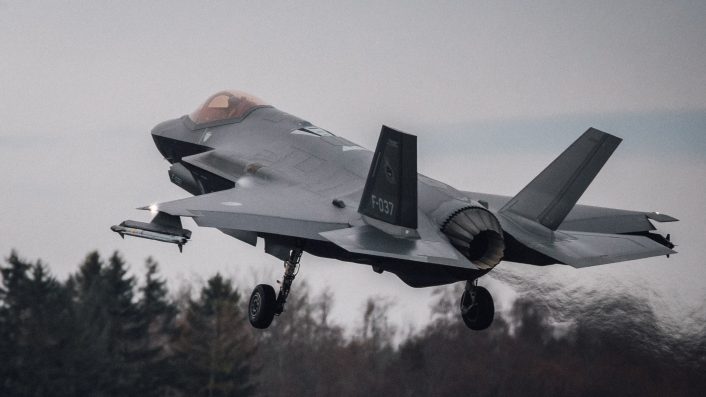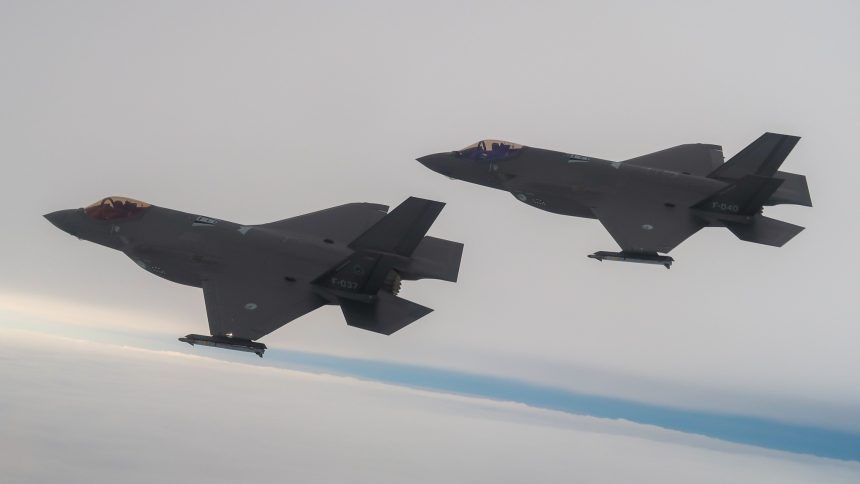During an exercise with the Estonian Air Force, two RLAF F-35s employed AIM-9 Sidewinder air-to-air missiles to shoot down a number of target drones over the Baltic Sea.
In an exceedingly rare exercise, two F-35As of the RNLAF (Royal Netherlands Air Force) shot down an unidentified number of target drones over the Baltic Sea using AIM-9 Sidewinder short-range AAMs (Air-to-Air Missiles), the service announced on Mar. 5, 2025. The Dutch F-35As are currently based in Estonia, where they deployed to Ämari Air Base in Dec. 2024 for the Baltic Air Policing (BAP) mission with a contingent of 90 to 150 airmen and four F-35As.
The service upheld the drill held on Mar. 4 off the coast of Rutja, saying that “for the pilots it was an excellent opportunity to practice shooting down unmanned systems ‘live’.” The RLAF further explained that “this is important, because they pose a real threat. They are increasingly being used as weapons.”
Images released by the service on its Instagram profile show four F-35As parked on the ramp, each loaded with two AIM-9X Sidewinders on the external launchers on the outermost hardpoints. The video shows the first F-35 releasing a Sidewinder from the left wing, and another airframe firing the missile from its right wing.
While the make and number of drones destroyed in the drill is not yet known, the video shows each of the fighters returning to base after having expended a single missile. This would imply that at least two drones were employed during the exercise.
Visualizza questo post su Instagram
Being able to engage and shoot down asymmetric threats like small drones is an important capability in current operational scenarios. For instance, an Israeli Air Force’s F-35I Adir downed a Houthi cruise missile fired from Yemen over the Red Sea towards Tel Aviv in Nov. 2023.
Russian drone and missile threat
A statement released by the Dutch Ministry of Defense attributed the motivation behind the exercise to a massive Russian standoff long-range munition and UAV strike on Ukraine last week.
“It is important to train the shooting down of unmanned systems ‘live’. They pose a real threat. They are increasingly used as weapons.
That was also evident last week. At that time, the Dutch F-35s helped to keep Polish airspace safe. The reason was a major Russian attack with missiles and drones on Ukraine, which borders Poland.”
This Quick Reaction Alert mission took place on Feb. 25, 2025, when two of the RNLAF fighters from the Estonia-based BAP detachment also deployed over Polish airspace in response to a“large missile and drone attack” launched by Russia on Ukraine. “Due to the scale of the enemy attack, NATO partners worked together to monitor the border area with Ukraine,” the Koninkhiljkeluchmacht said at the time.
Since the start of the BAP mission in Estonia, the Dutch F-35A contingent has been called in action ten times to intercept Russian aircraft, identifying a total of 18 aircraft, the MoD added.
View this post on Instagram
On Dec. 6, 2024, we reported here at The Aviationist that two of the RNLAF F-35As at Ämari engaged in two QRA (Quick Reaction Alert) missions and intercepted three Russian aircraft over the Baltic Sea. These were identified as an An-72 “Coaler” transport aircraft, a Su-24MR “Fencer E” reconnaissance aircraft and an Il-20 “Coot A” communication/electronic intelligence (COMINT/ELINT) aircraft.
Integrated air defense
The Estonian military’s press release quoted the commander of the RNLAF contingent, Lt. Col. Swinger, who touched upon the Dutch BAP deployment there.
“Our mission in Estonia is clear: securing the Baltic airspace. One of the F-35’s core functions is integrated air and missile defense, so this anti-drone exercise provided an excellent opportunity to once again demonstrate our capabilities in this area. Its planning and implementation with our ally Estonia confirms our joint effort to protect NATO territory,” said Swinger.
The Estonian Air Force controlled the conduct of the training activities with its air operations control squadron, coordinated the necessary airspace and sea area separation, securing the exercise, and the subsequent cleanup of the area, said the MoD.
Integrated air defense systems include linking fourth, 4.5 and fifth generation fighters with SAM (Surface-to-Air Missile) batteries, satellite surveillance and AEW&C (Airborne Early Warning and Control) aircraft. These coordinate to track, prioritize targets, and employ the optimal means to engage threats, based on their heading and make.

The SAM themselves include diverse weapons with point-defense, hybrid gun-and-missile platforms, short-range quick reaction, medium and long-range missiles in overlapping ranges of coverage, forming a protective shield. Israel’s combination of THAAD (Terminal High-Altitude Area Defense), David’s Sling, Arrow and Iron Dome is one such system. Its Russian counterpart is the S-400, S-300/S-350, Buk-M2, Tor-M2 and the Pantsir systems.
F-35, AIM-9 Sidewinder and drones
There are several reasons why the F-35s used the AIM-9X to destroy the drones. One of them is the small size of the drones used in the exercise, as this implies a smaller radar cross section which would make it harder to track them on radar and cue a radar-guided AIM-120 AMRAAM (Advanced Medium-Range Air-to-Air Missile) on them.
Another reason is the need for a cost-effective way of dealing with such threats, as demonstrated by the U.S. Air Force now using the Advanced Precision Kill Weapon System II (APKWS II) guided-rockets as a low-cost air-to-air weapon against drones. Using an AIM-120 instead of the AIM-9X would cost even more, while the drone costs just a few thousands of dollars.
The F-35s cannot carry the Sidewinder internally, but only on the external weapons stations. The AIM-9X Sidewinder was first live-fired from an F-35 on Jan. 12, 2016, when a jet from the 461st Flight Test Squadron at Edwards AFB in California launched it over the Pacific Sea Test Range.
2 🇳🇱 F-35’s hebben gisteren geholpen het Poolse luchtruim veilig te houden. Aanleiding daarvoor was een grote Russische aanval met raketten en drones op Oekraïne, dat aan de @NATO-bondgenoot grenst.
Lees meer 👉 https://t.co/dDkDo33Kxl pic.twitter.com/5lGMkXqH26
— Koninklijke Luchtmacht (@Kon_Luchtmacht) February 26, 2025
In the latest exercise, it is unclear from where the drones were launched and tracked, whether the fighters were scrambled upon being alerted by ground radars or if they detected the drones during a routine CAP (Combat Air Patrol). Either way, the F-35A’s advanced AN/APG-81 AESA (Active Electronically Scanned Array Radar) would have been used in combination with the EOTS (Electro-Optical Targeting System) to find the targets, before engaging them.
“In today’s security situation, drones are an increasingly greater threat in both war and peacetime, which is why it is important to conduct such exercises. The exercise can be considered successful because all training objectives were met,” said Brigadier General Toomas Susi, Commander of the Estonian Air Force.









